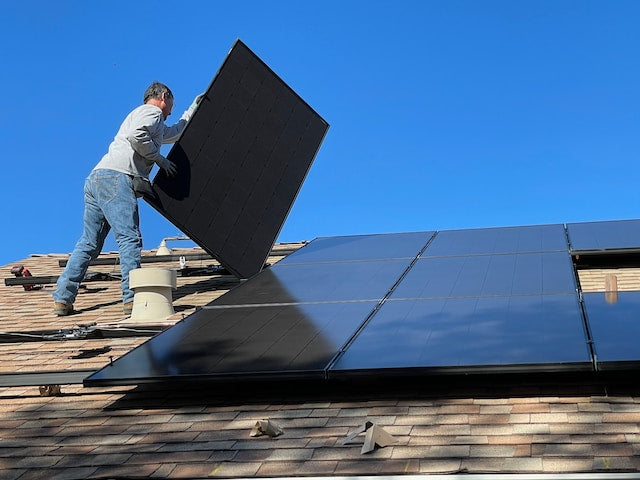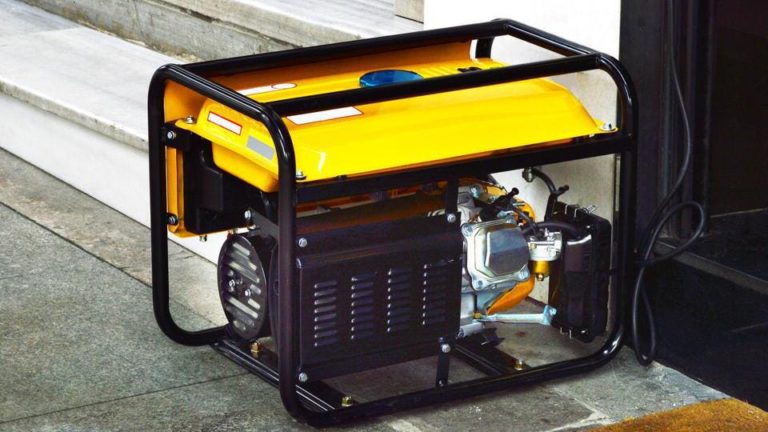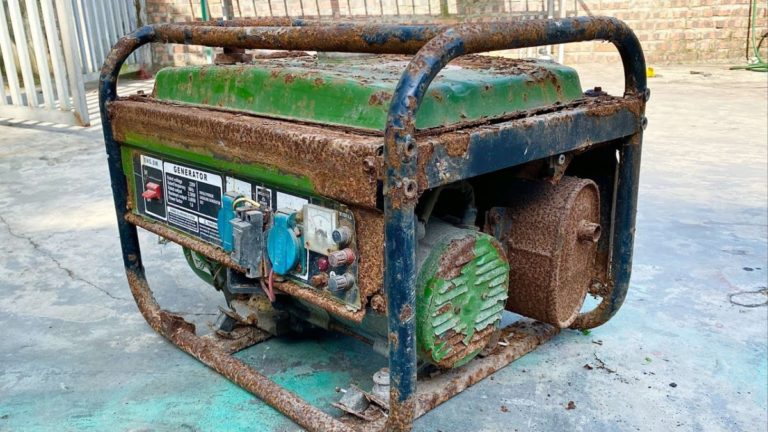These innovative technologies empower individuals and communities to generate their own energy, reducing reliance on centralized power sources and providing a more resilient and self-sufficient way of living.
From solar and wind power to hydrogen fuel cells and advanced battery storage, the possibilities for clean energy independence are expanding rapidly.
With the right tools and knowledge, anyone can take control of their energy future and enjoy the benefits of off-grid living.
Harness renewable energy sources
Consider using solar, wind, hydro, or geothermal energy to power your off-grid system. These sources are renewable and can help reduce your reliance on fossil fuels.
Renewable energy sources like solar, wind, hydro, and geothermal energy are abundant and sustainable, meaning they can be replenished naturally and will never run out.
These energy sources are also clean, producing no emissions or pollution, making them a healthier choice for the environment and for your wallet.
By harnessing renewable energy sources, you can significantly reduce your reliance on fossil fuels, which are finite resources that contribute to climate change and air pollution.
In particular, solar energy has become an increasingly popular choice for off-grid systems due to its accessibility and affordability.
Solar panels can be easily installed on rooftops or in open spaces, and they can be paired with energy storage systems like batteries to provide a reliable source of power.
Hydro energy can be harnessed through small-scale turbines or micro-hydro systems, which can be installed in streams or rivers.
Wind energy can also be captured using wind turbines, which can be installed on land or in the ocean.
Geothermal energy, which is derived from the heat of the Earth, can be harnessed through geothermal systems, which can be installed underground or in boreholes.
Overall, harnessing renewable energy sources is a smart and sustainable choice for powering an off-grid system.
Not only do these sources of energy reduce our reliance on fossil fuels, but they also provide a reliable and consistent source of power, often at a lower cost than traditional energy sources.
With the right technology and planning, it is now easier than ever to transition to renewable energy sources and live off the grid with confidence.
Off grid solutions are becoming increasingly popular as more people look for ways to live sustainably and reduce their reliance on public utilities.
One way to do this is to install renewable energy systems, such as solar panels, wind turbines, or hydroelectric power, to generate electricity.
These systems can be installed on rooftops or in open spaces, and can be paired with energy storage systems like batteries to provide a reliable source of power.
Hydro energy can be harnessed through small-scale turbines or micro-hydro systems, which can be installed in streams or rivers.
Wind energy can also be captured using wind turbines, which can be installed on land or in the ocean.
Geothermal energy, which is derived from the heat of the Earth, can be harnessed through geothermal systems, which can be installed underground or in open pits.
Off-grid living not only helps reduce reliance on public utilities, but it also helps reduce carbon footprint and promote sustainable living practices.
When choosing a renewable energy system, it’s important to consider factors such as cost, durability, and maintenance requirements.
It’s important to consider the local climate and resources when selecting the appropriate renewable energy system.
It is also important to consult with a professional before attempting to install a system.
Off-grid living not only helps reduce reliance on public utilities but also promote sustainable living practices, reduce carbon footprint.
Use energy-efficient appliances
Choose appliances that are designed to be energy-efficient, such as LED lighting, Energy Star-rated appliances, and power-saving devices.
Using energy-efficient appliances is a simple yet effective way to reduce your carbon footprint and lower your energy bills.
LED lighting, for example, uses significantly less energy than traditional incandescent bulbs and can last up to 25 times longer.
Energy Star-rated appliances, such as refrigerators, washing machines, and air conditioners, use up to 40% less energy than standard models.
Power-saving devices like smart power strips and timer switches can help you save energy by automatically turning off devices that are not in use.
Off-grid solutions, such as solar-powered appliances and wind turbines, can also provide a reliable source of energy without relying on the grid.
By choosing energy-efficient appliances and investing in off-grid solutions, you can significantly reduce your energy consumption and contribute to a more sustainable future.
Implement energy-saving technologies
Consider implementing energy-saving technologies such as smart home systems, energy management software, and energy-efficient HVAC systems.
Implementing energy-saving technologies is a important step towards living off the grid and reducing your carbon footprint.
Smart home systems, energy management software, and energy-efficient HVAC systems can all play a significant role in helping you achieve your energy goals.
Smart home systems, such as smart thermostats and lighting systems, can help you monitor and control your energy usage in real-time, while energy management software can help you optimize your energy usage and identify areas where you can make improvements.
Energy-efficient HVAC systems, such as geothermal heat pumps or solar-powered air conditioning, can also help you reduce your energy usage and save money on your energy bills.
By implementing these energy-saving technologies, you can not only reduce your energy usage but also increase your energy independence and take a step towards living off the grid.
Many of these technologies can also provide you with backup power during power outages, giving you peace of mind and additional security.
Off-grid solutions such as solar panels and wind turbines can also be integrated with these technologies to provide a reliable and renewable source of energy for your home.
Invest in energy storage
Invest in energy storage solutions such as batteries or flywheels to store excess energy generated from renewable sources and use it when needed.
Investing in energy storage solutions is a important step towards living off the grid.
Batteries and flywheels are reliable options for storing excess energy generated from renewable sources such as solar or wind power.
These energy storage solutions allow you to store excess energy during periods of low consumption and use it when needed, reducing your reliance on the grid and minimizing your energy bills.
Off-grid solutions like energy storage systems are becoming increasingly popular as they provide a cost-effective and sustainable way to power homes and businesses.
By investing in energy storage, you can reduce your carbon footprint, minimize your reliance on non-renewable energy sources, and enjoy long-term savings on your energy bills.
Moreover, with the advancement in energy storage technology, you have a wide range of options to choose from.
Lithium-ion batteries, for instance, are becoming increasingly popular for their high energy density, long lifespan, and reliable performance.
Similarly, flywheels are another reliable option that stores energy in the form of kinetic energy, providing a smooth and stable energy supply.
Investing in energy storage not only reduces your energy bills but also provides a sense of security in case of power outages or grid failures.
With an energy storage system, you can power your home or business even during periods of no grid supply, providing peace of mind and freedom from the limitations of traditional grid-connected living.
Overall, investing in energy storage solutions is a smart and practical decision for those looking to live off the grid or minimize their energy dependence.
With a wide range of options available, you can find an energy storage solution that suits your needs and budget, providing you with a reliable, sustainable, and cost-effective source of energy for years to come.
Use passive design
Design your home or building to take advantage of natural lighting, ventilation, and insulation. This can help reduce the need for mechanical systems and improve energy efficiency.
Passive design is an essential aspect of off-grid living, as it allows you to maximize natural resources and minimize the need for mechanical systems.
By carefully positioning windows, doors, and other openings, you can utilize natural lighting and ventilation to illuminate and freshen your space without relying on electricity or artificial heating and cooling.
This not only reduces your carbon footprint, but it also saves you money on energy costs.
Passive design can help you maintain a consistent indoor temperature, even in extreme weather conditions, by using natural insulation such as thick walls, well-insulated windows, and strategically-placed shading.
This can be especially important in off-grid locations where access to centralized heating and cooling systems may be limited.
Some key passive design strategies to consider include
* South-facing windows to maximize natural light and warmth from the sun
* Overhangs, awnings, or louvers to block direct sunlight and reduce heat gain in warm climates
* Insulation, such as recycled denim or wool, to maintain comfortable temperatures year-round
* Cross-ventilation, such as opening windows on opposite sides of the building, to create a natural breeze
* Thoughtful layout and placement of living spaces to take advantage of natural light and ventilation
By incorporating these passive design strategies into your home or building design, you can create a comfortable, energy-efficient, and off-grid-ready space that minimizes your reliance on mechanical systems and reduces your carbon footprint.
Integrate with smart grid
Consider integrating your off-grid system with the smart grid to optimize energy usage and reduce waste. This can also help you sell excess energy back to the grid.
Integrating your off-grid system with the smart grid can be a highly beneficial move, offering numerous advantages that can help you optimize your energy usage and reduce waste.
By connecting your off-grid system to the smart grid, you can sell excess energy back to the grid, generating additional revenue and further offsetting your energy costs.
This integration also allows for real-time monitoring and control of your energy usage, enabling you to make informed decisions about how to maximize your energy savings.
Smart grid integration can provide you with advanced features such as remote monitoring, automated system control, and predictive maintenance, all of which can help you minimize energy waste and improve the overall efficiency of your off-grid system.
Moreover, off-grid solutions such as solar panels, wind turbines, and energy storage systems can be seamlessly integrated into the smart grid, providing you with a reliable and sustainable source of energy.
These solutions can be designed to work together with your smart grid system, ensuring that you have a consistent and stable supply of energy, even during times of peak demand or when the grid is down.
Off-grid solutions can help you reduce your dependence on the grid and lower your energy costs, making you more self-sufficient and reducing your carbon footprint.
Integrating your off-grid system with the smart grid is a highly beneficial move that can help you optimize your energy usage, reduce waste, and generate additional revenue.
By incorporating off-grid solutions into your smart grid system, you can create a reliable, sustainable, and cost-effective energy solution that meets your needs and contributes to a more sustainable future.
Monitor and control
Monitor and control your off-grid system remotely using energy management software and smart home devices. This can help you optimize energy usage, detect potential issues, and make changes as needed.
Monitoring and controlling your off-grid system remotely is important to ensuring optimal energy usage and minimizing potential issues.
With energy management software and smart home devices, you can track your energy usage in real-time, identify areas for improvement, and make adjustments as needed.
For example, you can monitor your solar panel output, battery charging and discharging levels, and energy usage patterns to determine if your system is operating at peak efficiency.
You can also receive alerts and notifications when your system detects potential issues, such as unusual energy usage or fluctuations in power output.
With smart home devices, you can control your off-grid system remotely using your smartphone or tablet, allowing you to turn appliances on and off, adjust thermostat settings, and regulate lighting from anywhere in the world.
By leveraging these technologies, you can ensure that your off-grid system is running smoothly and efficiently, even when you’re not physically present.
Consider a hybrid system
Consider using a hybrid system that combines different renewable energy sources, such as solar and wind, to provide a reliable and consistent source of energy. This can also help reduce energy costs and improve energy independence.
One of the most effective ways to achieve energy independence and reduce energy costs is to consider a hybrid system that combines different renewable energy sources, such as solar and wind power.
By harnessing the strengths of each energy source, a hybrid system can provide a reliable and consistent source of energy, even when one or both of the energy sources are not producing at their full potential.
For example, when the sun is not shining, a solar-wind hybrid system can rely on the wind to continue generating electricity, ensuring that your home or business remains powered.
This type of system also allows for the optimization of energy production, as the solar and wind energy sources can be synchronized to produce the maximum amount of energy possible.
A hybrid system can help to reduce energy storage costs, as the system can use the excess energy generated during peak periods to offset energy consumption during non-peak periods.
Overall, a hybrid system is a great option for those looking to achieve energy independence and reduce their energy costs, especially for off-grid solutions.
Want More? Dive Deeper Here!
Hey there! If you’re the type who loves going down the rabbit hole of information (like we do), you’re in the right spot. We’ve pulled together some cool reads and resources that dive a bit deeper into the stuff we chat about on our site. Whether you’re just killing time or super into the topic, these picks might just be what you’re looking for. Happy reading!
- New technology makes homes more energy independent, helps divert power during blackouts | Texas A&M University Engineering
- The Producer Partnership Energy Independence Plan | Yale Center for Business and the Environment
- Yale Students Design an Off-Grid Renewable Energy System for a Montana Ranch | Yale Center for Business and the Environment
- Grassroots Energy Innovation | Institute for the Future of Innovation in Society
- (PDF) Off-grid Access to Electricity Innovation Challenge | Debajit Palit and Thomas Hebo Larsen – Academia.edu






